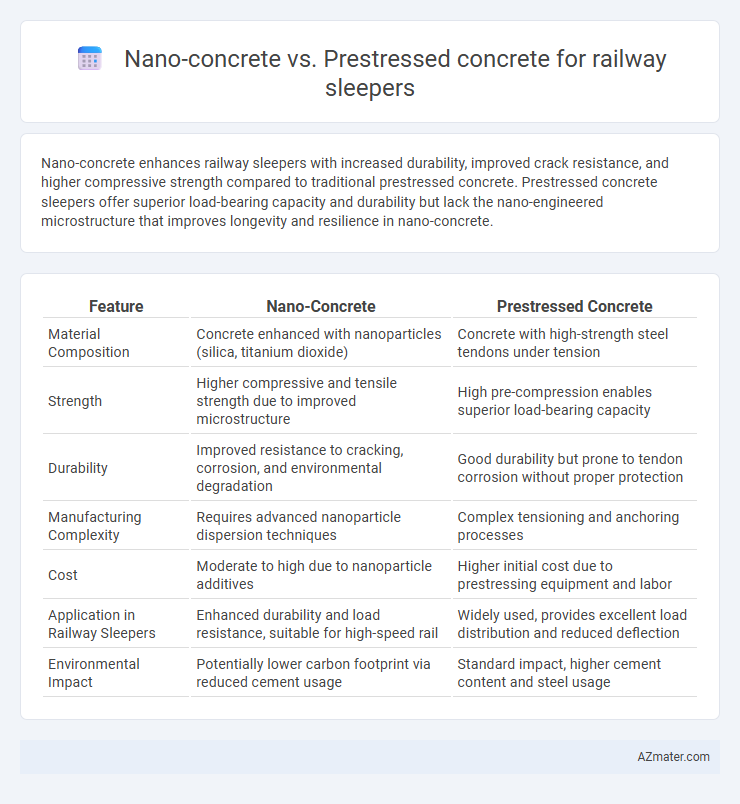Nano-concrete enhances railway sleepers with increased durability, improved crack resistance, and higher compressive strength compared to traditional prestressed concrete. Prestressed concrete sleepers offer superior load-bearing capacity and durability but lack the nano-engineered microstructure that improves longevity and resilience in nano-concrete.
Table of Comparison
| Feature | Nano-Concrete | Prestressed Concrete |
|---|---|---|
| Material Composition | Concrete enhanced with nanoparticles (silica, titanium dioxide) | Concrete with high-strength steel tendons under tension |
| Strength | Higher compressive and tensile strength due to improved microstructure | High pre-compression enables superior load-bearing capacity |
| Durability | Improved resistance to cracking, corrosion, and environmental degradation | Good durability but prone to tendon corrosion without proper protection |
| Manufacturing Complexity | Requires advanced nanoparticle dispersion techniques | Complex tensioning and anchoring processes |
| Cost | Moderate to high due to nanoparticle additives | Higher initial cost due to prestressing equipment and labor |
| Application in Railway Sleepers | Enhanced durability and load resistance, suitable for high-speed rail | Widely used, provides excellent load distribution and reduced deflection |
| Environmental Impact | Potentially lower carbon footprint via reduced cement usage | Standard impact, higher cement content and steel usage |
Introduction to Nano-Concrete and Prestressed Concrete
Nano-concrete incorporates nanoparticles such as nano-silica and carbon nanotubes to enhance mechanical properties, durability, and microstructure refinement, making it highly resistant to crack propagation and environmental degradation. Prestressed concrete sleepers utilize high-tensile steel tendons tensioned before loading to improve load-carrying capacity, reduce deflection, and resist dynamic forces from passing trains. Both materials offer significant advancements over traditional concrete, with nano-concrete optimizing material performance at the nanoscale and prestressed concrete providing superior structural strength and longevity for railway infrastructure.
Key Material Properties Comparison
Nano-concrete for railway sleepers exhibits enhanced microstructure with superior compressive strength, higher durability, and improved resistance to cracking compared to traditional prestressed concrete. Prestressed concrete offers excellent tensile strength due to embedded tensioned steel strands, providing high load-bearing capacity and long-span performance. The integration of nanoparticles in nano-concrete significantly increases modulus of elasticity and reduces porosity, resulting in better fatigue resistance and longevity under dynamic railway loads.
Manufacturing Processes of Railway Sleepers
Nano-concrete railway sleepers utilize advanced nanomaterials like nano-silica to enhance cement hydration, resulting in superior mechanical properties and durability compared to traditional concrete. The manufacturing process involves precise mixing, casting, and curing phases, where nano-additives improve particle packing density and reduce porosity, enabling faster curing times and higher strength development. In contrast, prestressed concrete sleepers incorporate high-tensile steel tendons tensioned before casting, requiring specialized equipment and strict quality controls to ensure effective stress transfer and long-term performance under dynamic rail loads.
Mechanical Strength and Durability
Nano-concrete enhances mechanical strength and durability for railway sleepers by incorporating nanoparticles that refine the microstructure, leading to higher compressive and flexural strength compared to traditional prestressed concrete. Prestressed concrete sleepers provide excellent load-bearing capacity and resistance to tensile stresses due to the pre-tensioning of steel tendons, but they are more susceptible to microcracking and environmental degradation over time. Nano-concrete exhibits superior durability against freeze-thaw cycles, chemical attacks, and wear, extending the lifespan of railway sleepers under dynamic loading conditions.
Resistance to Environmental Factors
Nano-concrete exhibits enhanced resistance to environmental factors such as chloride penetration, freeze-thaw cycles, and carbonation due to its densely packed microstructure and reduced porosity. Prestressed concrete sleepers offer high durability against mechanical stresses but are more susceptible to microcracking and corrosion in aggressive environments if not properly protected. Studies demonstrate nano-engineered concrete's superior performance in harsh weather and chemical exposure, extending the service life of railway sleepers.
Cost Analysis and Economic Feasibility
Nano-concrete offers enhanced durability and reduced maintenance costs for railway sleepers, potentially lowering lifecycle expenses compared to traditional prestressed concrete. Initial production costs of nano-concrete are higher due to advanced materials and technology, but its longer service life and resistance to environmental degradation improve overall economic feasibility. Prestressed concrete remains cost-effective for large-scale projects due to established manufacturing processes, yet nano-concrete's innovation may lead to cost savings in the long term through decreased repair frequency and enhanced performance.
Sustainability and Environmental Impact
Nano-concrete sleepers enhance sustainability by incorporating nanoparticles that improve durability and reduce material consumption compared to traditional prestressed concrete, leading to lower carbon footprints. The extended lifespan of nano-concrete reduces the frequency of replacements, minimizing resource extraction and waste generation. In contrast, prestressed concrete requires high energy inputs during manufacturing and has limited recyclability, resulting in a greater environmental impact over the sleeper's lifecycle.
Performance in Real-world Railway Conditions
Nano-concrete exhibits enhanced durability and resistance to micro-cracking under cyclic loads, significantly improving the lifespan of railway sleepers in high-traffic zones compared to traditional prestressed concrete. Its superior nano-scale additives increase toughness and reduce permeability, leading to better performance against environmental degradation such as freeze-thaw cycles and chemical exposure from de-icing salts. While prestressed concrete offers high initial load-bearing capacity, nano-concrete's advanced properties result in reduced maintenance costs and improved long-term reliability in real-world railway conditions.
Maintenance Requirements and Lifecycle
Nano-concrete railway sleepers exhibit significantly enhanced durability and reduced micro-cracking compared to prestressed concrete, resulting in lower maintenance requirements over their lifecycle. The nano-engineered materials improve resistance to environmental degradation and mechanical stress, extending the service life and minimizing repair interventions. Prestressed concrete sleepers, while offering high initial strength, typically demand more frequent inspections and minor repairs to address stress-induced wear and potential cracking throughout their operational lifespan.
Future Trends in Railway Sleeper Technology
Nano-concrete enhances material properties like durability and crack resistance in railway sleepers through the inclusion of nano-sized additives, offering a promising advancement over traditional prestressed concrete. Future trends in railway sleeper technology emphasize the integration of nano-engineered materials to improve longevity and reduce maintenance costs, while prestressed concrete remains essential for its superior load-bearing capabilities and structural integrity. The convergence of nano-concrete innovations with prestressing techniques is expected to drive the next generation of high-performance, sustainable railway sleepers.

Infographic: Nano-concrete vs Prestressed concrete for Railway sleeper
 azmater.com
azmater.com